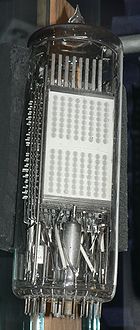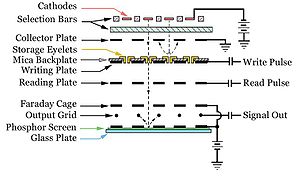
Selectron tube
Encyclopedia
The Selectron was an early form of digital computer memory
developed by Jan A. Rajchman
and his group at the Radio Corporation of America under the direction of Vladimir Zworykin
, of television technology fame. The team was never able to produce a commercially viable form of Selectron before core memory became almost universal, and it remains practically unknown today.

 Development of Selectron started in 1946 at the behest of John von Neumann
Development of Selectron started in 1946 at the behest of John von Neumann
of the Institute for Advanced Study
, who was in the midst of designing the IAS machine
and was looking for a new form of high-speed memory. RCA responded with the Selectron with a capacity of 4096 bits, with a planned production of 200 by the end of the year. They found the device to be much more difficult to build than expected, and they were still not available by the middle of 1948. As development dragged on, the IAS machine was forced to switch to Williams tube
s for storage, and the primary customer for Selectron disappeared.
RCA continued work on the concept, re-designing it for a smaller 256-bit capacity. The 256-bit Selectron was projected to cost about $500 each when in full production. While they were more reliable and faster than the Williams tube, that cost and the lack of availability, meant they were used only in one computer: the RAND Corporation's JOHNNIAC
.
Both the Selectron and the Williams tube were superseded in the market by the more compact and cost effective magnetic core memory
, in the early 1950s.
configured as 1024 by 4 bits. It had an indirectly heated cathode
running up the middle, surrounded by two separate sets of wires—one radial, one axial—forming a cylindrical grid array, and finally a dielectric storage material coating on the inside of four segments of an enclosing metal cylinder called the signal plates. The bits were stored as discrete regions of charge on the smooth surface of the signal plates.
The two sets of orthogonal grid wires were normally "biased" slightly positive, so that the electrons from the cathode could flow through the grid and reach the dielectric. The continuous flow of electrons allowed the stored charge to be continuously regenerated by the secondary emission
of electrons. To select a bit to be read from or written to, all but two adjacent wires on each of the two grids were biased negative, allowing current to flow to the dielectric at one location only.
Writing was accomplished by selecting a bit, as above, and then sending a pulse of potential, either positive or negative, to the signal plate. With a bit selected, electrons would be pulled onto (with a positive potential) or pushed from (negative potential) the dielectric. When the bias on the grid was dropped, the electrons were trapped on the dielectric as a spot of static electricity.
 To read from the device a bit location was selected and a pulse sent from the cathode. If the dielectric for that bit contained a charge, the electrons would be pushed off the dielectric and read as a brief pulse of current in the signal plate. No such pulse meant that the dielectric must not have held a charge.
To read from the device a bit location was selected and a pulse sent from the cathode. If the dielectric for that bit contained a charge, the electrons would be pushed off the dielectric and read as a brief pulse of current in the signal plate. No such pulse meant that the dielectric must not have held a charge.
The smaller capacity 256-bit (128 by 2 bits) "production" device was in a similar vacuum tube envelope. It was built with two storage arrays of discrete "eyelets" on a rectangular plate, separated by a row of eight cathodes. The pin count was reduced from 44 for the 4096-bit device down to 31 pins and two coaxial signal output connectors. This version included visible green phosphors in each eyelet so that the bit status could also be read manually.
Computer memory
In computing, memory refers to the physical devices used to store programs or data on a temporary or permanent basis for use in a computer or other digital electronic device. The term primary memory is used for the information in physical systems which are fast In computing, memory refers to the...
developed by Jan A. Rajchman
Jan A. Rajchman
Jan Aleksander Rajchman was an American electrical engineer and computer pioneer.He received the Diploma of Electrical Engineering from the Swiss Federal Institute of Technology in Zurich in 1935, and became a Doctor of Science in 1938.Rajchman emigrated to America in 1935. He joined RCA...
and his group at the Radio Corporation of America under the direction of Vladimir Zworykin
Vladimir Zworykin
Vladimir Kozmich Zworykin was a Russian-American inventor, engineer, and pioneer of television technology. Zworykin invented a television transmitting and receiving system employing cathode ray tubes...
, of television technology fame. The team was never able to produce a commercially viable form of Selectron before core memory became almost universal, and it remains practically unknown today.
Development


John von Neumann
John von Neumann was a Hungarian-American mathematician and polymath who made major contributions to a vast number of fields, including set theory, functional analysis, quantum mechanics, ergodic theory, geometry, fluid dynamics, economics and game theory, computer science, numerical analysis,...
of the Institute for Advanced Study
Institute for Advanced Study
The Institute for Advanced Study, located in Princeton, New Jersey, United States, is an independent postgraduate center for theoretical research and intellectual inquiry. It was founded in 1930 by Abraham Flexner...
, who was in the midst of designing the IAS machine
IAS machine
The IAS machine was the first electronic computer built by the Institute for Advanced Study , in Princeton, New Jersey, USA. It is sometimes called the von Neuman machine, since the paper describing its design was edited by John von Neumann, a mathematics professor at both Princeton University...
and was looking for a new form of high-speed memory. RCA responded with the Selectron with a capacity of 4096 bits, with a planned production of 200 by the end of the year. They found the device to be much more difficult to build than expected, and they were still not available by the middle of 1948. As development dragged on, the IAS machine was forced to switch to Williams tube
Williams tube
The Williams tube or the Williams-Kilburn tube , developed in about 1946 or 1947, was a cathode ray tube used to electronically store binary data....
s for storage, and the primary customer for Selectron disappeared.
RCA continued work on the concept, re-designing it for a smaller 256-bit capacity. The 256-bit Selectron was projected to cost about $500 each when in full production. While they were more reliable and faster than the Williams tube, that cost and the lack of availability, meant they were used only in one computer: the RAND Corporation's JOHNNIAC
JOHNNIAC
The JOHNNIAC was an early computer built by RAND that was based on the von Neumann architecture that had been pioneered on the IAS machine. It was named in honor of von Neumann, short for John v. Neumann Numerical Integrator and Automatic Computer...
.
Both the Selectron and the Williams tube were superseded in the market by the more compact and cost effective magnetic core memory
Magnetic core memory
Magnetic-core memory was the predominant form of random-access computer memory for 20 years . It uses tiny magnetic toroids , the cores, through which wires are threaded to write and read information. Each core represents one bit of information...
, in the early 1950s.
Design
The original 4096-bit Selectron was a 10 inches (254 mm) by 3 inches (76.2 mm) vacuum tubeVacuum tube
In electronics, a vacuum tube, electron tube , or thermionic valve , reduced to simply "tube" or "valve" in everyday parlance, is a device that relies on the flow of electric current through a vacuum...
configured as 1024 by 4 bits. It had an indirectly heated cathode
Cathode
A cathode is an electrode through which electric current flows out of a polarized electrical device. Mnemonic: CCD .Cathode polarity is not always negative...
running up the middle, surrounded by two separate sets of wires—one radial, one axial—forming a cylindrical grid array, and finally a dielectric storage material coating on the inside of four segments of an enclosing metal cylinder called the signal plates. The bits were stored as discrete regions of charge on the smooth surface of the signal plates.
The two sets of orthogonal grid wires were normally "biased" slightly positive, so that the electrons from the cathode could flow through the grid and reach the dielectric. The continuous flow of electrons allowed the stored charge to be continuously regenerated by the secondary emission
Secondary emission
Secondary emission in physics is a phenomenon where primary incident particles of sufficient energy, when hitting a surface or passing through some material, induce the emission of secondary particles. The primary particles are often charged particles like electrons or ions. If the secondary...
of electrons. To select a bit to be read from or written to, all but two adjacent wires on each of the two grids were biased negative, allowing current to flow to the dielectric at one location only.
Writing was accomplished by selecting a bit, as above, and then sending a pulse of potential, either positive or negative, to the signal plate. With a bit selected, electrons would be pulled onto (with a positive potential) or pushed from (negative potential) the dielectric. When the bias on the grid was dropped, the electrons were trapped on the dielectric as a spot of static electricity.

The smaller capacity 256-bit (128 by 2 bits) "production" device was in a similar vacuum tube envelope. It was built with two storage arrays of discrete "eyelets" on a rectangular plate, separated by a row of eight cathodes. The pin count was reduced from 44 for the 4096-bit device down to 31 pins and two coaxial signal output connectors. This version included visible green phosphors in each eyelet so that the bit status could also be read manually.
External links
- The Selectron
- Early Devices display: Memories – has a picture of a 256-bit Selectron about halfway down the page
- History of the RCA Selectron

